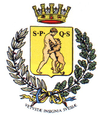Sessa Aurunca
| Sessa Aurunca | ||
|---|---|---|
| Comune | ||
| Comune di Sessa Aurunca | ||
| ||
 Sessa Aurunca Location of Sessa Aurunca in Italy | ||
| Coordinates: 41°14′N 13°56′E / 41.233°N 13.933°ECoordinates: 41°14′N 13°56′E / 41.233°N 13.933°E | ||
| Country | Italy | |
| Region | Campania | |
| Province / Metropolitan city | Caserta (CE) | |
| Frazioni | Aulpi, Avezzano, Baia Domizia, Carano, Cascano, Cescheto, Corbara, Corigliano, Cupa, Fasani, Fontanaradina, Gusti, Lauro, Li Paoli, Maiano, Marzuli, Piedimonte, Ponte, Rongolise, San Carlo, San Castrese, San Martino, Santa Maria a Valogno, Sorbello, Tuoro, Valogno | |
| Government | ||
| • Mayor | Silvio Sasso | |
| Area | ||
| • Total | 163 km2 (63 sq mi) | |
| Elevation | 203 m (666 ft) | |
| Population (28 February 2015) | ||
| • Total | 21,840 | |
| • Density | 130/km2 (350/sq mi) | |
| Demonym(s) | Sessani | |
| Time zone | CET (UTC+1) | |
| • Summer (DST) | CEST (UTC+2) | |
| Postal code | 81037 | |
| Dialing code | 0823 | |
| Patron saint | St. Leo IX | |
| Saint day | May 8 | |
| Website | Official website | |
Sessa Aurunca is a town and comune of Campania, Italy, in the province of Caserta. It located on the south west slope of the extinct volcano of Roccamonfina, 40 kilometres (25 mi) by rail west north west of Caserta and 30 kilometres (19 mi) east of Formia.
It is situated on the site of the ancient Suessa Aurunca, near the river Garigliano. The hill on which Sessa lies is a mass of volcanic tuff.
History
The ancient chief town of the Aurunci, is believed to have lain over 600 m above the level of the sea, on the narrow south-western edge of the extinct crater of Roccamonfina. Here some remains of Cyclopean masonry exist; but the area enclosed, about 100 by 50 metres (330 by 160 ft), is too small for anything but a detached fort. It dates more probably from a time prior to Roman supremacy.
In 337 BC the town was abandoned under the pressure of the Sidicini, in favour of the site of the modern Sessa. The new town kept the old name until 313, when a Latin colony under the name Suessa Aurunca was founded here. It was among the towns that had the right of coinage, and it manufactured carts, baskets and others. Cicero speaks of it as a place of some importance. The triumviri settled some of their veterans here, whence it appears as Colonia Julia Felix Classica Suessa. From inscriptions it appears that Matidia the younger, sister-in-law of Hadrian, had property in the district. It was not on a highroad, but on a branch between the Via Appia at Minturnae and the Via Latina crater mentioned.
Main sights
The town contains many ancient remains, notably the ruins of an ancient bridge in brickwork of twenty-one arches, of substructures in opus reticulatum under the church of S. Benedetto, of a building in opus quadratum, supposed to have been a public portico, under the monastery of S. Giovanni, and of an amphitheatre.
The Romanesque cathedral is a medieval basilica with a vaulted portico and a nave and two aisles begun in 1103, a mosaic pavement in the Cosmatesque style, a good ambo resting on columns and decorated with mosaics showing traces of Moorish influence, a Paschal candelabrum, and an organ gallery of similar style. The portal has sculptures with scenes from the life of Saint Peter and Saint Paul. In the principal streets are memorial stones with inscriptions in honour of Charles V, surmounted by an old crucifix with a mosaic cross. The hills of Sessa are celebrated for their wine.
Tourism
Baia Domizia is the brand-new small resort town of the comune of Sessa Aurunca. The village was built since 1964 and is located near the river Garigliano, inside an Italian pine forest and nice volcanic sand beaches. It is a holiday town with 11 kilometres (7 mi) of private beaches. The village offers a superb combination of sea, sand and sightseeing. Baia Domizia gained the status of a main destination of summer tourism on the Litorale Domizio and is one of the best known seaside resorts in Campania Region.
Transportation
Sessa Aurunca is connected by railway to Naples and Rome.
See also
External links
- Purcell, N., R. Talbert, T. Elliott, S. Gillies. "Places: 433132 (Suessa Aurunca)". Pleiades. Retrieved March 8, 2012.
![]() This article incorporates text from a publication now in the public domain: Chisholm, Hugh, ed. (1911). "Sessa Aurunca". Encyclopædia Britannica. 24 (11th ed.). Cambridge University Press. pp. 701–702.
This article incorporates text from a publication now in the public domain: Chisholm, Hugh, ed. (1911). "Sessa Aurunca". Encyclopædia Britannica. 24 (11th ed.). Cambridge University Press. pp. 701–702.
